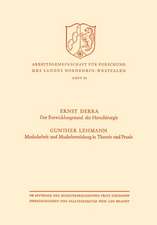Brain Edema: Proceedings of the Symposium September 11–13, 1965, Vienna
Editat de Igor Klatzo, Franz Seitelbergeren Limba Engleză Paperback – 11 feb 2012
Preț: 737.69 lei
Preț vechi: 776.52 lei
-5% Nou
Puncte Express: 1107
Preț estimativ în valută:
141.18€ • 146.84$ • 116.55£
141.18€ • 146.84$ • 116.55£
Carte tipărită la comandă
Livrare economică 14-28 aprilie
Preluare comenzi: 021 569.72.76
Specificații
ISBN-13: 9783709175477
ISBN-10: 370917547X
Pagini: 700
Ilustrații: XVIII, 700 p. 277 illus., 11 illus. in color.
Dimensiuni: 152 x 229 x 43 mm
Greutate: 0.96 kg
Ediția:Softcover reprint of the original 1st ed. 1967
Editura: SPRINGER VIENNA
Colecția Springer
Locul publicării:Vienna, Austria
ISBN-10: 370917547X
Pagini: 700
Ilustrații: XVIII, 700 p. 277 illus., 11 illus. in color.
Dimensiuni: 152 x 229 x 43 mm
Greutate: 0.96 kg
Ediția:Softcover reprint of the original 1st ed. 1967
Editura: SPRINGER VIENNA
Colecția Springer
Locul publicării:Vienna, Austria
Public țintă
ResearchDescriere
The Symposium on Brain Edema has been organized by the Osterreichische Arbeitsgemeinschaft fur Neuropathologie and by the Problem Commission for Neuropathology of the World Federa tion of Neurology. We would like to express our thanks to Dr. L. van Bogaert, president of the W.F.N., for his great interest in the design of this conference and for his energetic support. One of the aims ofthe Problem Commission for Neuropathology has been to contribute to the advances in various problems which are becoming ripe for elucidation by experts in different fields. The idea of the Symposium on Brain Edema has as its background a compelling necessity to elucidate this subject which is clinically so important and neuropathologic ally so poorly understood. It was hoped that this could be achieved by a multidisciplinary approach involving a variety of aspects to be discussed and correlated. Brain edema, being an abnormal cerebral condition, belongs basically to the sphere of neuropathology, but to be successful in our endeavors we had to apply neuropathology in its most modern and widest terms. By this we understand that such neuropathology includes the study of all abnormal phenomena in the nervous tissue related to the structural alterations, and by "structural" we mean not only tissual or cellular ones but also changes on ultrastructural and molecular levels. Thus we needed close and integrated coopera tion of experts in fields such as neurohistology, histochemistry, electron microscopy, neurochemistry, and neurophysiology.
Cuprins
I. Clinical Aspects of Brain Edema.- Brain Edema as a Neurological Problem—I.- Brain Edema as a Neurological Problem—II.- Brain Edema as a Neurological Problem—III.- Brain Edema: Some Clinical and Experimental Correlations.- Hypoxia and Brain Edema: Some Anesthesiological Correlations.- Brain Edema as the Anatomical Substrate of Supratentorial Cerebral Pseudotumors.- Discussion.- II. Brain Edema in Human Pathology.- Neuropathological Aspects and Histological Criteria of Brain Edema and Brain Swelling.- Course and Sequelae of Brain Edema.- Sequence of Pathological Changes in Brain Edema.- The Problem of Status Spongiosus.- Ultrastructural Aspects of Status Spongiosus.- Electron Microscopic Observations in Creutzfeld-Jakob Disease.- Discussion.- II. Brain Edema in Human Pathology (Continued).- Chemical Aspects of Edematous Brain.- Hydrosoluble Proteins of Edematous Human Nervous Tissue.- Electron Miscroscopic Observations on Human Brain Edema Studied in Biopsy Material.- Lead Encephalopathy in Suckling Rats.- Observations on the White Matter in Human Brain Edema.- Edema in Peripheral Nerves.- Morphological Substrate of the Blood-Brain Barrier in Human Brain Tumors.- Discussion.- III. Fluid Compartments, Electrolytes and Transport Mechanisms.- Movement Within the Brain of Ferritin Injected into the Cerebrospinal Fluid Compartments.- Morphological Compartments in the Central Nervous System.- Distribution of Cerebral Fluids and Electrolytes In Vivo and In Vitro.- Brain Extracellular Space as Measured by Diffusion of Various Molecules into Brain.- Kinetics of Cerebrospinal Fluid Exchanges.- Regional Differences in Transport of Substances out of the Cerebrospinal Fluid.- Model of the Blood-Brain Barrier System.- Specificity of Cerebral Amino Acid Transport.- Brain Edema and Glucose Transport Across the Blood-Brain Barrier.- Carbon Dioxide and Acid-Base Equilibria in Brain Tissue.- Discussion.- IV. Experimental Studies on Brain Edema.- Ultrastructural Substrates of Experimental Cerebral Edema.- Biochemical Studies on Experimental Brain Edema.- Biochemical Correlates of Cerebral Edema.- Histochemical Aspects of Brain Edema.- Histochemical Study of Different Types of Brain Edema.- Some Remarks About Experimental Brain Edema.- Specificity of Electron Microscopic Localization of Phosphatase Activity to Cerebral Fine Structure.- Discussion.- IV. Experimental Studies on Brain Edema (Cont.).- Radio-Isotopic Studies in Brain Edema.- Tin Poisoning Edema.- The Chemistry of Isolated Edema Fluid in Experimental Cerebral Injury.- Dynamics of Cold Injury Edema.- Alterations in the Intraventricular Pressure in Cats After Cold Induced Edema.- Fine Structure of Cerebral Fluid Accumulation.- Electron Miscroscopic Studies on Experimental Brain Edema.- Electron Microscopic Observations on Different Models of Acute Experimental Brain Edema.- Brain Edema Induced by Particle and Ultraviolet Radiation.- Brain Edema Due to Ionizing Radiation.- Effects of X-Irradiation on Guinea Pig Brain.- Histological and Histochemical Aspects of the Early Effects of Roentgen Irradiation on the Nervous System of Rabbits.- Discussion.- Round Table Discussion.

























